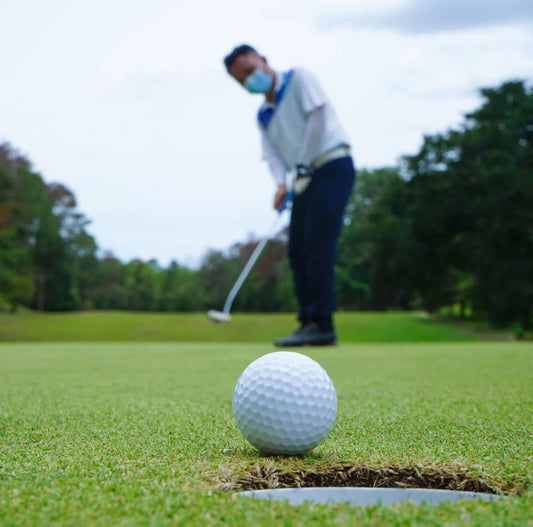Whereas some industries are still struggling to recover from the effects of COVID-19, the golf industry is experiencing the opposite—a massive boom in popularity. The industry has grown as the overall number of rounds played has also skyrocketed. Why golf, though, and not other activities? The answer is simple—golf’s outdoor environment made it safe enough to continue even when social distancing practices were at their height.
If you were an avid golfer before the pandemic, you likely noticed this surge firsthand. Whether it’s a lag in wait time for equipment you ordered weeks ago or the inability to get a tee time at your favorite course, these problems and others are new to the industry.
Before COVID, the golf industry was slowing down, and many industry experts were concerned for its future. However, with the worst of the pandemic (hopefully) behind us, the tune has changed, and the golf business is booming.
How Golf Courses Adapted During the Pandemic
Since golf is an individual sport that is played outdoors and does not require shared equipment, it was one of the few safe leisure activities that was able to be enjoyed during most stages of the early pandemic. However, some tweaks were introduced to make the game even safer to play for those able.
One popular change was that course staff removed rakes and bunkers from play so multiple people didn’t have to touch the same item and potentially expose themselves to infection. Instead, players moved their golf balls as if they were in another person's footprint in the bunker. They could not move the ball closer to the hole or out of the bunker.
Players could, however, take relief at the nearest point to where the ball would come to rest in the bunker if it was outside of the footprint and still in the bunker, still no closer to the hole. If relief in such a manner was unattainable, players could pick up their golf ball, smooth out the disturbed sand, and replace their ball.
Thanks to a rule implemented before the COVID era, flag sticks were already allowed to remain in the hole while putting for golfers who preferred it. In COVID times, though, most courses required flag sticks to remain in the hole, and, many times, pool noodles were cut and placed in the bottom, so balls hovered just above the cup’s edge for easy, touch-free retrieval.
Some golf courses created other ways to make it easier to get your ball out of the hole with variations to the foam. Some courses had a touchless lever you could hook your putter head under that would lift the ball out of the hole. Others installed PVC piping in the bottom of the cups, reducing the number of infection opportunities.
The adjustments to retrieving your ball from the hole weren’t the only changes. Some courses spaced out the amount of time between tees or set up outdoor check-in stations as additional precautions.
When it came to golf cart usage, some courses only allowed one player per golf cart unless they were part of the same household. Golf carts were also thoroughly sanitized as they came in. And for those courses allowing two riders to a cart, plastic partitions were often placed in the middle to separate each player from potential infection.
More People Playing Golf Than Ever Before
Not only have more people turned to golf since the onset of the pandemic, but the total purses on tour for professionals have also spiked.
In 2022, the PGA Tour saw the season’s overall purse total increase to $421 million. For the LPGA, they saw a 12% increase in total prize money, which totaled $86 million.
With all the new people picking up the game, retailers also saw a parallel surge in business. The PGA Superstore alone has seen a 90% increase in sales over the last two years. This jump in sales for the PGA Superstore is a testament to how drastically the golf industry has changed with COVID.
With such massive growth in sales, production and shipping logistics struggled to keep up for retailers and manufacturers alike. Not being able to anticipate the 6% increase in rounds played nationally, which equaled almost 30 million rounds across the country, you can imagine how many more golf balls, gloves, tees, hats, shoes, clubs, and other accessories like putting mats were purchased. As good as it was for companies to see the increases in business, it was difficult to keep up with the new demand across the board.
The pandemic's impact on the golf industry didn’t die off as the pandemic waned. People continue to play golf in record numbers, country club memberships are up, and manufacturers and retailers are still trying to catch up with the demand for golf supplies.
For those unable or not wanting to go to a course, golfing from the comfort of their own home has become an option that many hadn’t previously considered. With the help of indoor putting mats and launch monitors, you could set up your own putting green in your backyard, making it easy to practice at home and escape the work-from-home grind.
Frequently Asked Questions
Still curious about how COVID has impacted the golf industry? Here are the answers to some frequently asked questions we’ve received.
Did the pandemic negatively impact the golf industry?
Quite the opposite. The golf industry saw a surge like never before, both in the number of rounds played and sales for retailers and manufacturers.
Did people still play golf during the pandemic?
Yes! Golfers made many adaptations to the game to make it as safe as possible, and not sharing equipment helped golfers feel comfortable enough to continue playing during the pandemic.
Did the golf industry go back to normal after the pandemic?
The number of rounds played and dollars spent at retailers in the golf industry has not decreased to pre-pandemic levels yet. However, the rounds and dollars have started to level off. When the sharp increase stopped, courses and retailers adapted but it has set a new normal for the golfing business.





